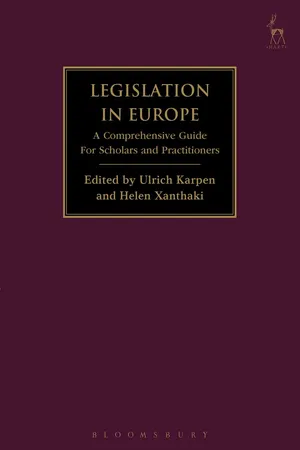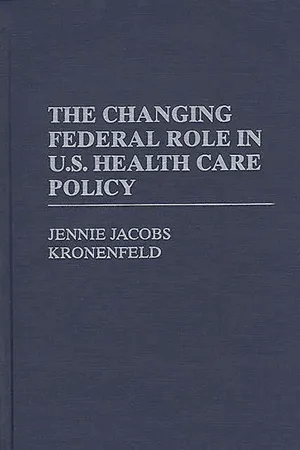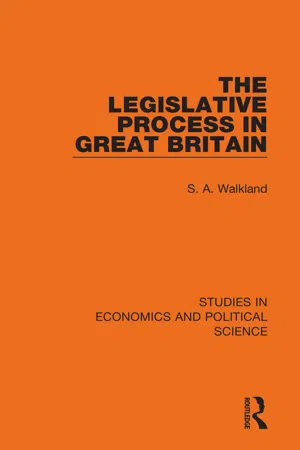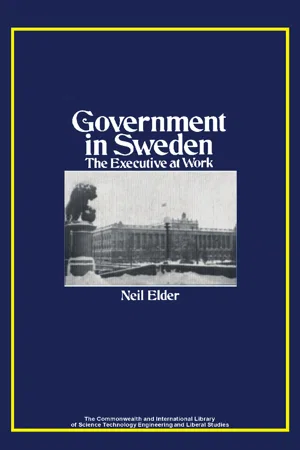Politics & International Relations
Legislative Process
The legislative process refers to the series of steps through which a bill becomes law. It typically involves drafting a bill, committee review, debate, and voting in the legislative body. The process may also include amendments, reconciliation between different versions of the bill, and ultimately, approval by the executive branch.
Written by Perlego with AI-assistance
Related key terms
1 of 5
4 Key excerpts on "Legislative Process"
- eBook - PDF
Legislation in Europe
A Comprehensive Guide For Scholars and Practitioners
- Ulrich Karpen, Helen Xanthaki, Ulrich Karpen, Helen Xanthaki(Authors)
- 2017(Publication Date)
- Hart Publishing(Publisher)
It is not easy, or even possible, 35 Legislative Process 6 I Bogdanovskaia, ‘The Legislative Bodies in the Law Making Process’, available at www.nato.int/acad/ fellow/97-99/bogdanovskaia.pdf (accessed on 8 March 2014). See also the five stages in law making in GC Thornton, Legislative drafting (London, Butterworths, 1987). 7 For more on this, see T Drinóczi, ‘Constitutional Dialogue Theories—Extension of the Concept and Exam-ples from Hungary’ (2013) 1 Zeitschrift für öffentliches Recht 87. For common law, see R Cormacain, ‘Retroactivity, Retrospectivity, and Legislative Competence in Northern Ireland: Determining the Validity of Janus-Faced Legis-lation’ [2015] Statute Law Review 134, 10.1093/slr/hmu054. to strictly divide the processes and organs taking part in the processes, though to elabo-rate the topic of Legislative Processes and address the issues mentioned it seems necessary, howsoever artificial it may seem. 3.2. Regulation and Organisation Legislation itself is a cyclic action of the state, but each legislative action (such as policy making, drafting, negotiating, consulting) is also cyclic to a certain extent as they require a continuous decision-making process fitted to the particular legislative action. Thus, com-ponents of ordinary decision making are applied throughout the Legislative Process, in each phase and by each body involved. These elements are: identifying the problem; analysing the start-up situation, as well as the reasons leading to that situation; determining the leg-islative aim; analysing the possibilities of reaching the aim; evaluating alternatives based on the aim; decision making; and monitoring the result. As can be seen, the greater part of the law-making process is a political as well as ordinary decision-making process and, in principle, cannot be regulated by law. - Jennie Jacobs Kronenfeld(Author)
- 1997(Publication Date)
- Praeger(Publisher)
Development of Legislation As contrasted with agenda-setting—a process whose steps vary greatly depending upon timing and the issue itself—the development of legislation mostly follows a set pattern. The Legislative Process begins with proposals in the legislature (Congress at the federal level), gener- ally called bills but sometimes resolutions. Many more bills are intro- duced into Congress each year than are ever passed. Those not passed die at the end of that session of Congress. Any senator or representative can introduce legislation. Normally, staff members play an important role in its drafting, as may organized interest groups in complex areas such as health. Bills can be introduced into only one chamber of Congress, or identical legislation may be introduced into both chambers (this is generally the process if the president is proposing legislation). After being introduced, bills are assigned to the appropriate committee in each chamber for further study and consideration. The majority party in each chamber controls the appointment of committees and chairper- sons of committees, and the chairpersons exert great power within the Legislative Process because they determine the order and the pace of consideration of legislative proposals. Typically, hearings are held on proposed legislation, often by a subcommittee but sometimes by the whole committee. After hearings, the bill is marked up, that is any changes will be made to the bill in a line-by-line process. The bill is Health Policy Process at the National Level and the Role of Politics 59 reported out to the full committee with jurisdiction over the topic. Following approval by the full committee, the bill is discharged with a bill report, which contains information about the history of the bill and the reasons the committee has decided to approve it. The next step is placement on the legislative calendar for floor action.- eBook - ePub
- S. A. Walkland(Author)
- 2021(Publication Date)
- Routledge(Publisher)
Legislation as a ProcessThe end-products of legislation are easily recognized. They are Acts of Parliament as published in the Statutes Revised, and the contents of the collected annual volumes of Statutory Instruments.Difficulties arise, however, when a conceptual definition of legislation is attempted—to try to show how, in substance, legislation differs from other broad governmental processes such as administration and adjudication. Attempts at a rigid classification along conceptual lines break down at the margins, and the conclusion cannot be avoided that the main differences between the ways in which determinations of public questions are made in any governmental system are largely procedural, and do not relate to any general inherent functional differences between the main activities of public authorities.A conceptual definition of legislation which is often attempted states that it consists, to quote one authority, ‘of the making of determinations which are issued to indicated but unnamed and unspecified persons or situations’.1 Here the important characteristic of legislation is regarded as being that of generality of application. Another definition, substantially similar, and attempting to distinguish between legislation and the work of the courts, suggests that legislation normally ‘affects the rights of individuals in the abstract and must be applied in a further proceeding before the legal position of an individual will be touched by it, whilst adjudication operates concretely upon individuals in their individual capacity’.2 The Donoughmore-Scott Report on Ministers’ Powers in 1932 similarly held that ‘the power to issue a particular command’ was ‘in no sense legislative’.3 Other attempts at defining a legislative function rely on the fact that legislation characteristically looks to the future, whilst judicial enquiries investigate present or past facts.1 K. C. Davis, Administrative Law - eBook - PDF
Government in Sweden
The Executive at Work
- Neil C. M. Elder, Nevil Johnson(Authors)
- 2013(Publication Date)
- Pergamon(Publisher)
In what follows, therefore, the Legislative Process will be understood to refer to the making of laws with the co-operation of Parliament, though the discussion can legitimately be enlarged to include government propositions and parliamentary motions. The Government submits on average about 200 propositions a year for parliamentary consideration. 5 By no means all of these, however, can be reckoned as Bills in the normal sense : many con-tain proposals for expenditure and for raising revenue which supple-ment and clarify the annual statement on the condition and require-ments of the administration sent in to the Riksdag in January, at the very beginning of the session, as Proposition No. 1 (statsverkspro-positionen). In the case of important and complex reforms, again, two propositions are commonly submitted: the first contains the financial implications of the measure, the second the legal text. Each proposition may well comprise a small volume in itself, because the supporting documentation is very considerable. It is possible that the weight of written material might decrease if ministers were to be given free access to the meetings of the parlia-mentary standing committees. But the tradition of setting out the rationale of every measure at length is very strong, and the process of circulating reform projects for comment by interested admini-strative and private agencies, and incorporating these comments in the draft, stimulates reasoned discussion and reasoned reaction. Ng 4 Malmgren, op. cit., pp. 95-97, is one useful commentary. 5 1959-64, annual average 197*6 propositions and messages—the latter being very few in number. 122 Government in Sweden draft, of course, can cover every contingency, and so the Govern-ment is empowered to issue regulations within the general frame-work approved by Parliament.
Index pages curate the most relevant extracts from our library of academic textbooks. They’ve been created using an in-house natural language model (NLM), each adding context and meaning to key research topics.



